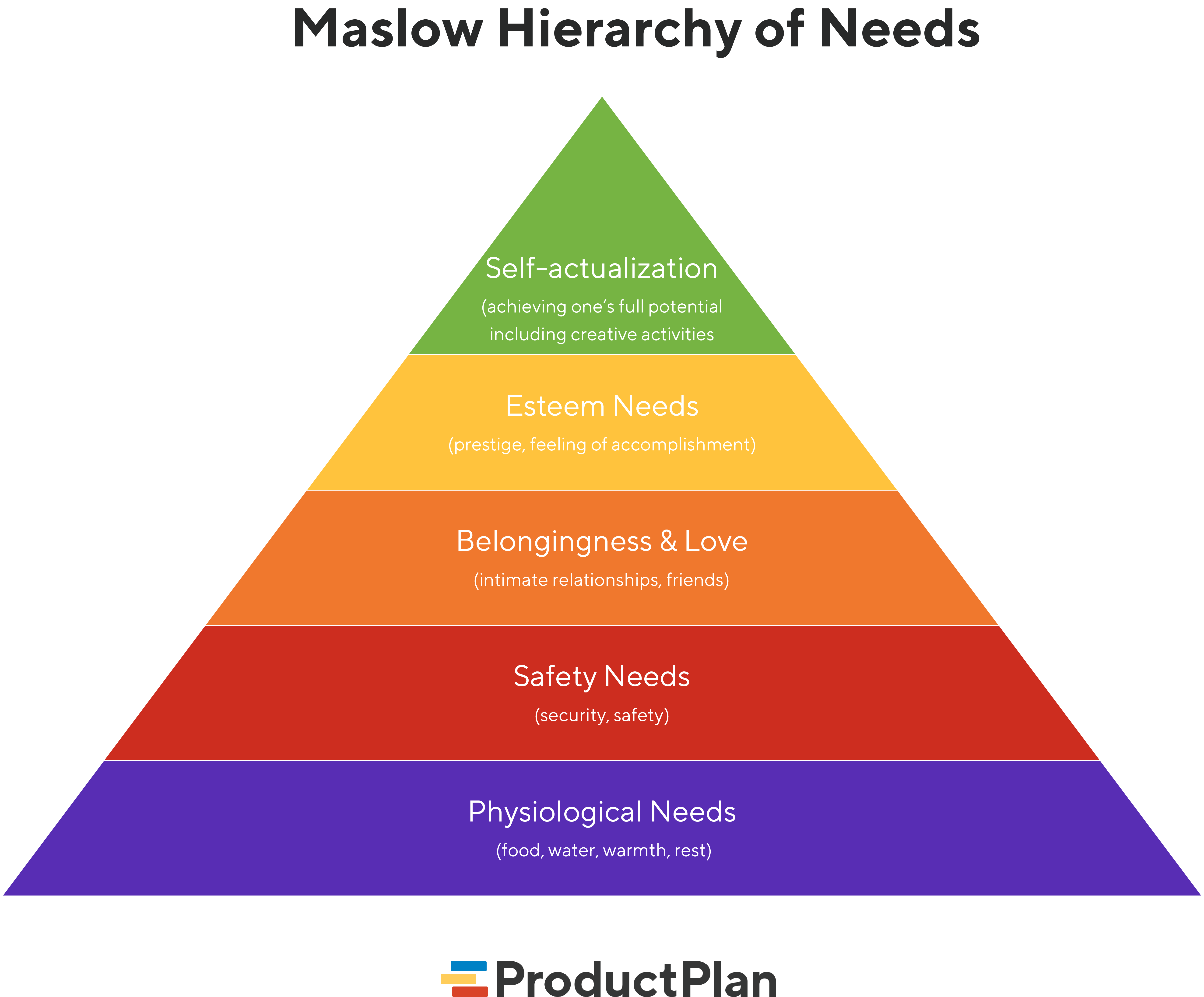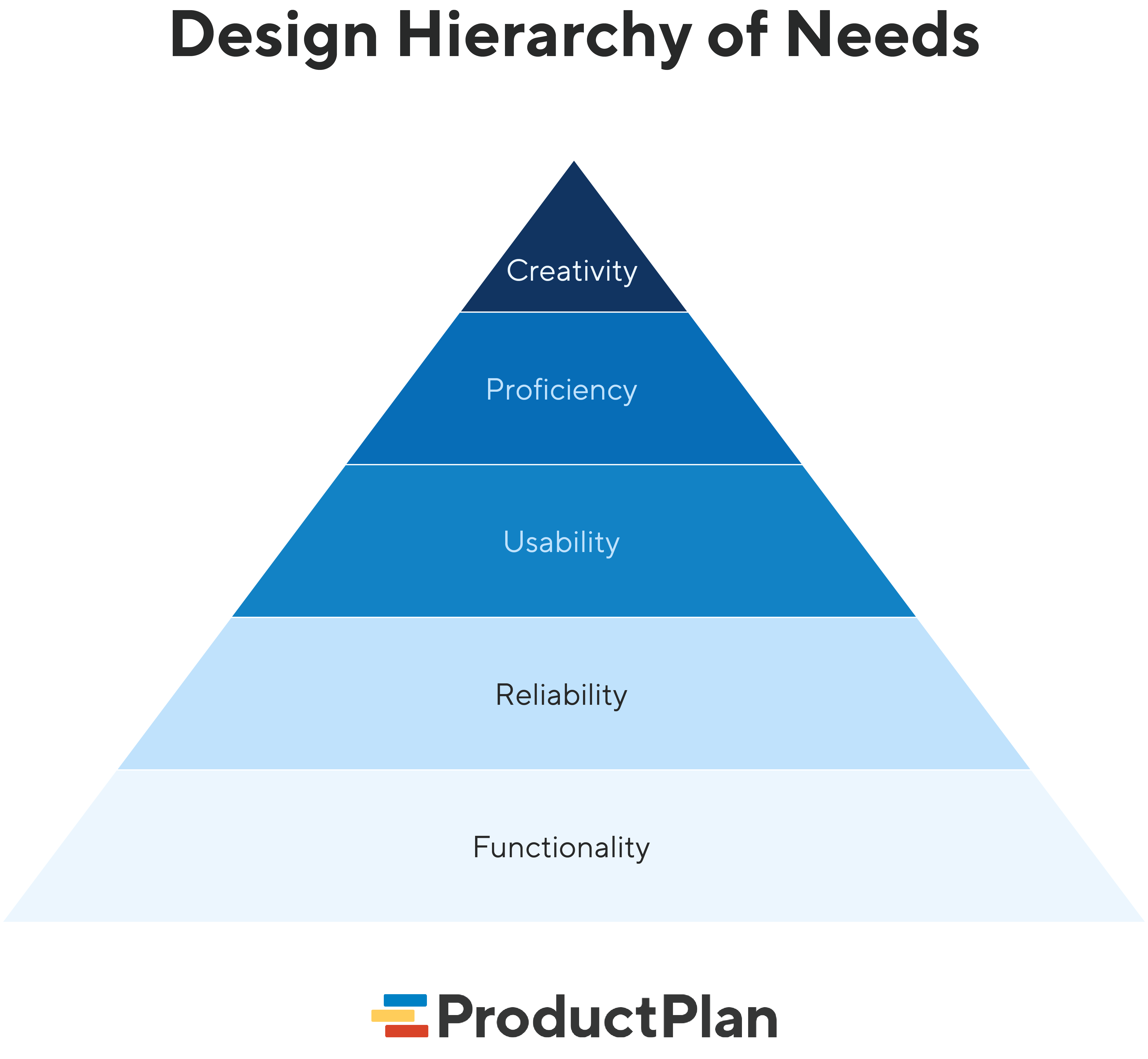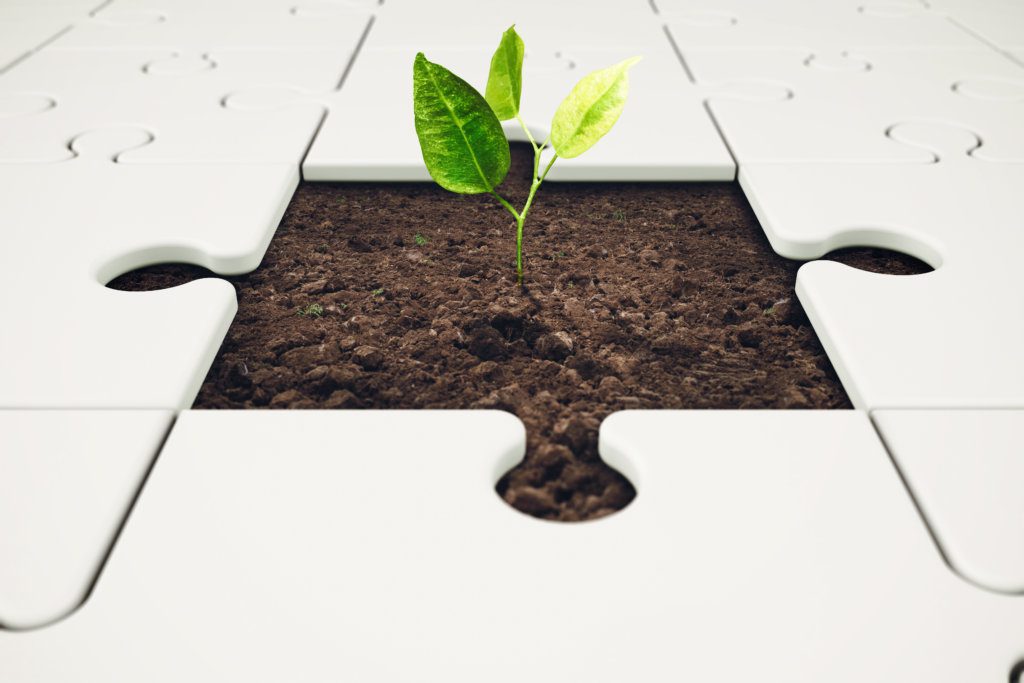In this blog, we will discuss the applications of Maslow’s Hierarchy of needs to the world of product design and tips to use this model most effectively to create your product. But first, we must start with the theory itself.
Maslow’s Hierarchy of Needs
Maslow’s Hierarchy of Needs is a motivational theory in psychology created by U.S psychologist Abraham Maslow. This theory was published in the academic journal Psychological Review in 1943 and is usually depicted using a five-tier model showing human needs in a pyramid diagram.
The needs at the bottom of the pyramid are the most basic. To progress to the next level, the current level must be satisfied. The needs are physiological, safety, love and belonging, esteem, and self-actualization from bottom to top.

The theory’s meaning.
The theory says that humans are motivated to fulfill basic needs before they move onto more advanced needs. For example, a person who has no food will not concentrate their time and resources seeking a loving relationship (belonging). They are instead evolutionarily compelled to meet their survival needs first (physiological).
Product Design and Maslow’s Theory
Over time, Maslow’s theory has been adapted and applied in many new fields. These range from medical treatments to marketing. However, in this article, we will discuss its application to product design and planning.
In 2010, Steven Bradley created a translation of Maslow’s theory- the “Design Hierarchy of Needs.” As with the original theory, the basic needs of design must be met first to progress to the next stage. The five tiers of Bradley’s theory are functionality, reliability, usability, proficiency, and creativity.

Design Hierarchy of Needs
Steven Bradley’s Design Hierarchy of Needs presents a useful and practical set of rules for creating new products and evaluating existing ones’ design. Moving through the process as you design a new product – be that a new piece of software or a tool to be used in the construction industry – is as simple as asking the questions each level implies.
- Functionality — Does it work?
- Reliability — Does it work when I need it to?
- Usability — Can I figure out how to make it work?
- Proficiency — Can it show me how to make it work better?
- Creativity — How else can this work for me?
The key here is to ask designers and customers these questions and listen intently to the answers.
The 5 Levels and 6 Rules to Follow When Using Bradley’s Hierarchy of Needs in Product Design
Fulfilling each stage of the hierarchy of needs is about using logic to design a product that meets its purpose’s functional imperatives. However, it is also about exploring how a product can work for a user outside its core remit. Therefore, creating a comprehensively satisfying product.
Level 1 – Functionality
The most basic yet critical part of a product’s design is its functionality. Does the mug, chainsaw, security software, etc., fulfill its primary objective? If it does not, then there is little point advancing to the other stages of development.
For example, it matters little if a water glass is beautiful if it cannot hold water and be used for drinking. It is useless and, therefore, valueless to consumers.
Order management software we can use as a good example for the digital world. If you can’t order goods and services using the software, developers should not move on to creating complex suggestion features, as the core requirements need to be addressed first.
This process obviously becomes more complicated as the core utilities of the product get more complex. This is not mistakenly illustrated as the largest part of the pyramid and, thus, its foundation. As the diagram’s proportion suggests, most of the time and resources allotted to you should focus on fulfilling this part of the process. It’s important to keep your customers or users in mind and answer the key question of if the product serves its primary function.
Rule 1
Always conduct in-depth research into what your customers expect your product to be able to do. A good way to understand your product’s basic functionalities is consumer research.
Apart from direct forms such as surveys, social media listening can also help you learn about your audience and what they expect from your services. This is especially pertinent when designing complicated pieces of software or other multi-purpose products. Asking what your product’s minimum expectations are when it comes to its use should guide you to fulfill this most crucial of design stages.
Level 2 – Reliability
Almost as fundamental to design as functionality is reliability. Can the user trust that the product will work 100% of the time? If a user does not trust your product to work each time required, are they likely to want to invest in it?
When it comes to creating a reliable product, the key is thorough testing. However, continue testing to ensure that it works time and time again in the same conditions. Testing should be as varied as possible.
Hower products mean little without the systems to support them. Therefore, a small tip to be aware of is to make sure that your product/service is reliable and that the various systems that support it are too.
A good way to improve performance and reliability when it comes to, for example, the workforce that supports your product is to employ the use of WFO solutions. These integrated solutions will allow you to monitor customer demand and how well your team meets it.
Rule 2
Test Test Test.
As mentioned, creating a reliable product involves a great deal of testing. There are four types of reliability testing that you should take into account.
The types of reliability testing are:
- Discovery Testing: This is the type of testing concerned with determining the boundaries for given inputs or stresses.
- Life testing: This type of testing looks at how a product will perform over its lifetime and through regular use.
- Environmental Testing: This type of testing looks at what set of stresses and conditions your product will expect the customer to work under.
- Regulatory testing – This testing, although not usually associated with those mentioned above, is an important set of tests that look at the product’s key functions for compliance and safety. Failure to meet regulatory testing usually means a product may need to be removed from the market.
Level 3- Usability
This need stresses the ability of people to use your product with ease. Can the user figure out how to use your product and each of its functions with minimal instruction?
For example, a new set of Bluetooth speakers are always relied on to amplify music through a Bluetooth-compatible device. However, if users find syncing their mobile device and controlling volume unintuitive, your product may struggle to win users’ approval.
Another more complex example would be a telephone IRV system. The best IVR meaning or definition is an automated telephone menu system that enables callers to be directed to the appropriate service quickly without being routed by a human, thus saving companies time and money.
This system needs to interact with callers and direct them to the correct information or human service but needs to do so in a user-friendly way. If the service is not designed with usability at its core, people will not want to use the service again.
Rule 3
Never think of instructions as an afterthought.
Developing quality instructions and literature to accompany your product is a vital part of the project. Put considered time and effort into explaining how to use your product as clear and well ordered as possible.
The trick is not to assume that customers have any prior knowledge about the product. Start from the basics and work up toward the more complicated functions.
Level 4 – Proficiency
With this need, we start to understand what makes a really good design. To satisfy this tier, designers need to ask themselves if a product’s design helps users become better at using that product. This need is especially relevant to computer software such as booking systems or review apps.
For example, a photo editing app designed for your phone could fulfill this need by suggesting tools and effects as you interact with the app. In addition to suggestions, it might also provide tutorials on various aspects of its app. Therefore, by using the app, you also get better at understanding its full range of functions.
Rule 4
Always be thinking, ‘what else could this product do?’.
A helpful way to think of proficiency in design is by considering if something empowers the user to do more than the product’s basic function.
Does it lead you to discover a new and better way of doing things? Is it, in a sense, progressive? With each interaction with the device, does the user discover more about its capabilities? Keeping the idea of expansion and forward motion can give designers a good visual idea of design proficiency.
Level 5- Creativity
Having proved that a product can reliably perform its core duties, the next step is to fulfill other needs through an injection of innovation. Take running shoes, for example. Their main function is to provide support and traction to users whilst running. You could argue that they also need to be comfortable and well made.
However, truly appealing running shoes on the market satisfy these needs amply and fulfill less tangible needs.
Desirable running shoes are aesthetically pleasing in a variety of colors and styles. In addition to running shoes needing to perform, they also need to fulfill the customer’s desire to own something visually stimulating.
This has its own parallel to Maslow’s Hierarchy of Needs. Once a human has the basics – in this case, the shoes work well to run in – they will then look to more complicated needs. For example, what do these shoes say about who I am? How can these shoes imply my social status?
Rule 5
Get Creative
Creativity is about going beyond the strict necessities of a product and looking for inventive ways to fulfill the customer’s needs.
Wrapping up and the final rule
As shown above, Bradley’s design hierarchy is a useful process for thinking of most products’ design aspirations. However, like Maslow’s original theory, which had its own catalog of critics, Bradley’s is not perfect, either.
Criticisms for the Design Hierarchy of Needs include questions like: does a design have to be reliable before it can be usable? Can’t both criteria be met simultaneously?
Also, will markets tolerate products that work 90% of the time or even 80%, as long as the function is good? For example, we often forgive our laptops the occasional glitch because we realize the complexity of tasks they undertake.
Rule 6
The hierarchy of design needs is by no means perfect and cannot be relied upon for every product design aspect.
The Maslow-inspired Design Hierarchy of Needs is an excellent place to start for product design, and you could do much worse than base your design upon its structures. However, the finer minutiae of products will need further research beyond this paradigm.
One of these finer levels that could be added to the pyramid, for example, is the use of history or story in your product or service. Often customers like to buy products that have prestige or tradition implied in their name.
Finally, we create products for human needs. Therefore, it follows that Maslow’s Hierarchy of Needs and any other psychological work looking at human necessities – basic and complex – have a wealth of translatable knowledge applied to the world of product design.






